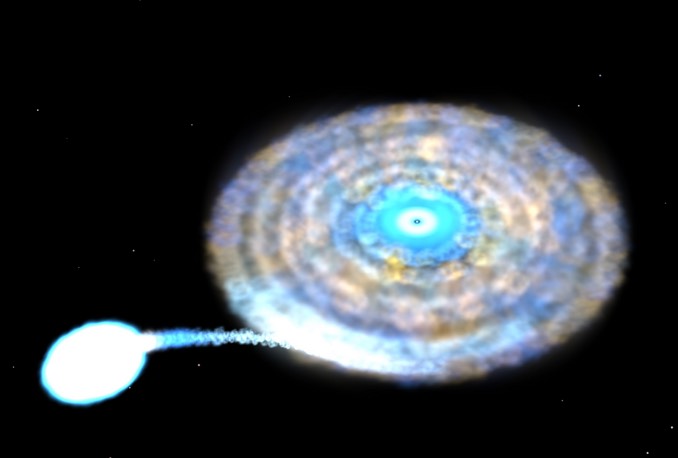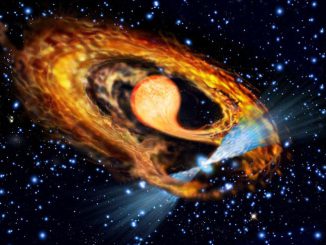
Imagine a compact white dwarf and a fast-spinning pulsar, the collapsed remnant of a once-massive star, whipping around their common center of mass in a binary system with the pulsar, rotating 9,800 times per minute on its axis, sucking gas away from the white dwarf and emitting rapid-fire blasts of X-rays.
Now imagine the two partners are just 300,000 kilometres apart (186,000 miles), less than the distance between the Earth and the Moon. At that close range, it’s no surprise they whip around each other at extremely high speed. But an orbital period of just 38 minutes?
That’s a new record for this class of millisecond X-ray pulsar binary. And it tells astronomers the pulsar’s companion most likely is, in fact, a white dwarf.
“It’s not possible for a hydrogen-rich star, like our Sun, to be the pulsar’s companion,” said Tod Strohmayer an astrophysicist at Goddard and lead author on a paper describing the new observations. “You can’t fit a star like that into an orbit so small.”
The record-setting binary – IGR J17062-6143 – was first detected in 2008 during a 20-minute observation by NASA’s Rossi X-ray Timing Explorer (ROSSI) spacecraft, which plunged back into the atmosphere last month after a long, successful mission.
ROSSI was able to determine how fast the pulsar was spinning, detecting 163 X-ray pulses per second, but it was unable to determine the binary’s orbital period.
But an instrument built in part to carry on ROSSI’s work, the Neutron Star Interior Composition Explorer, or NICER, was able to do just that from its perch aboard the International Space Station.
Installed aboard the station last June, NICER observed J17062 last August for more than seven hours. Additional observations in October and November helped astronomers pin down the period.
As it turns out, the J17062 stars rotate around each other in a circular orbit. The white dwarf is about 1.5 percent the mass of the Sun while the pulsar is much heavier at around 1.4 solar masses. They orbit a common center of gravity about 1,900 miles from the pulsar.
Accreting millisecond X-ray pulsars, or AMXPs, emit X-rays when gas from a companion star is sucked away, spiralling along powerful magnetic field lines and crashing onto the pulsar’s surface, creating hot spots. As a pulsar spins, the hot spots rotate into and out of view, resulting in the flashes seen by NICER and other instruments.
X-ray fluctuations from pulsars are extremely predictable. A companion instrument aboard the space station with NICER already has shown that pulsars can be used for deep space navigation in much the same way signals from GPS satellites are used for navigation on Earth.



